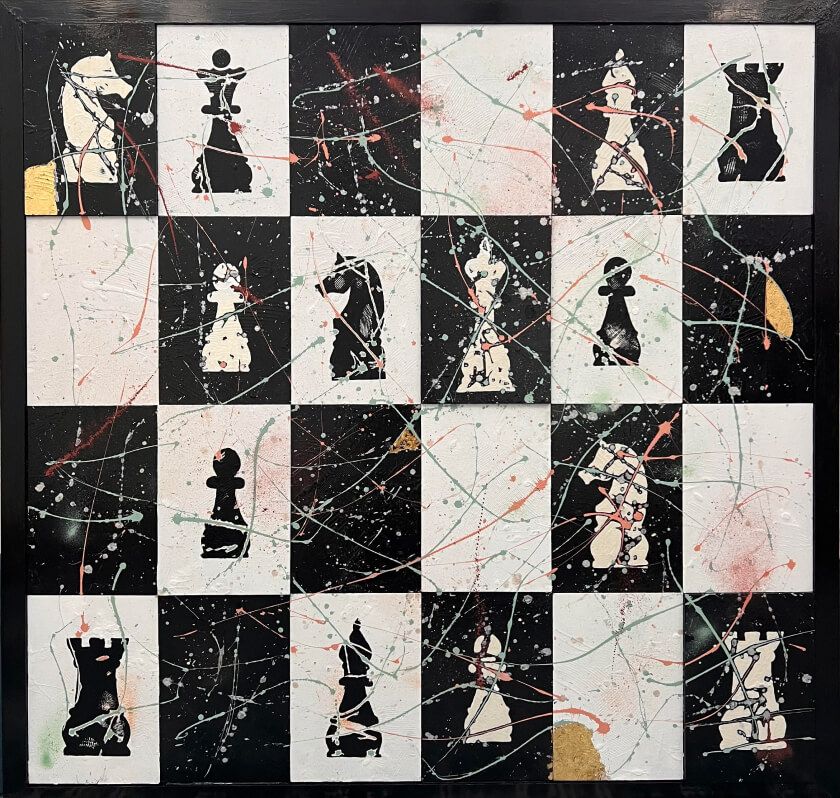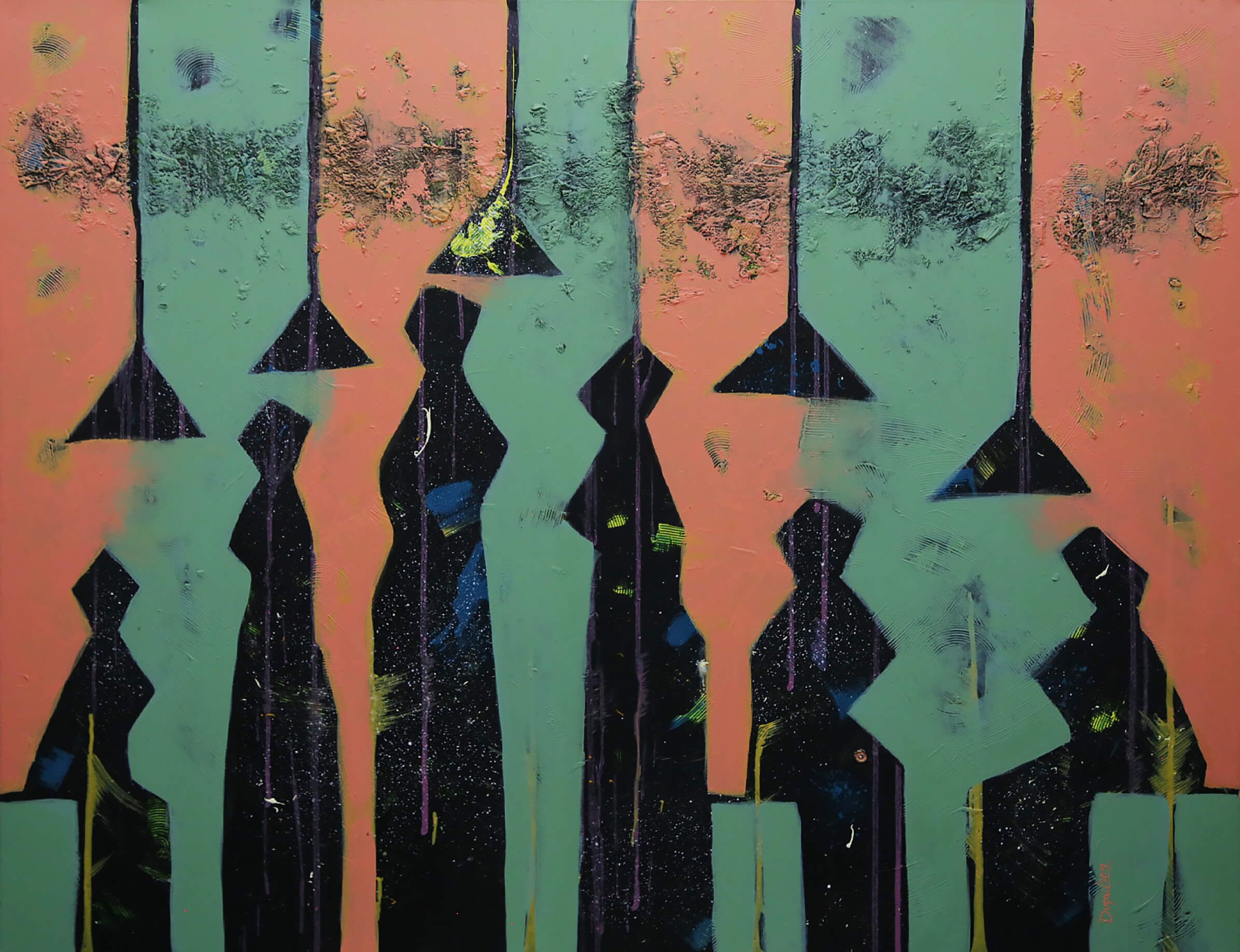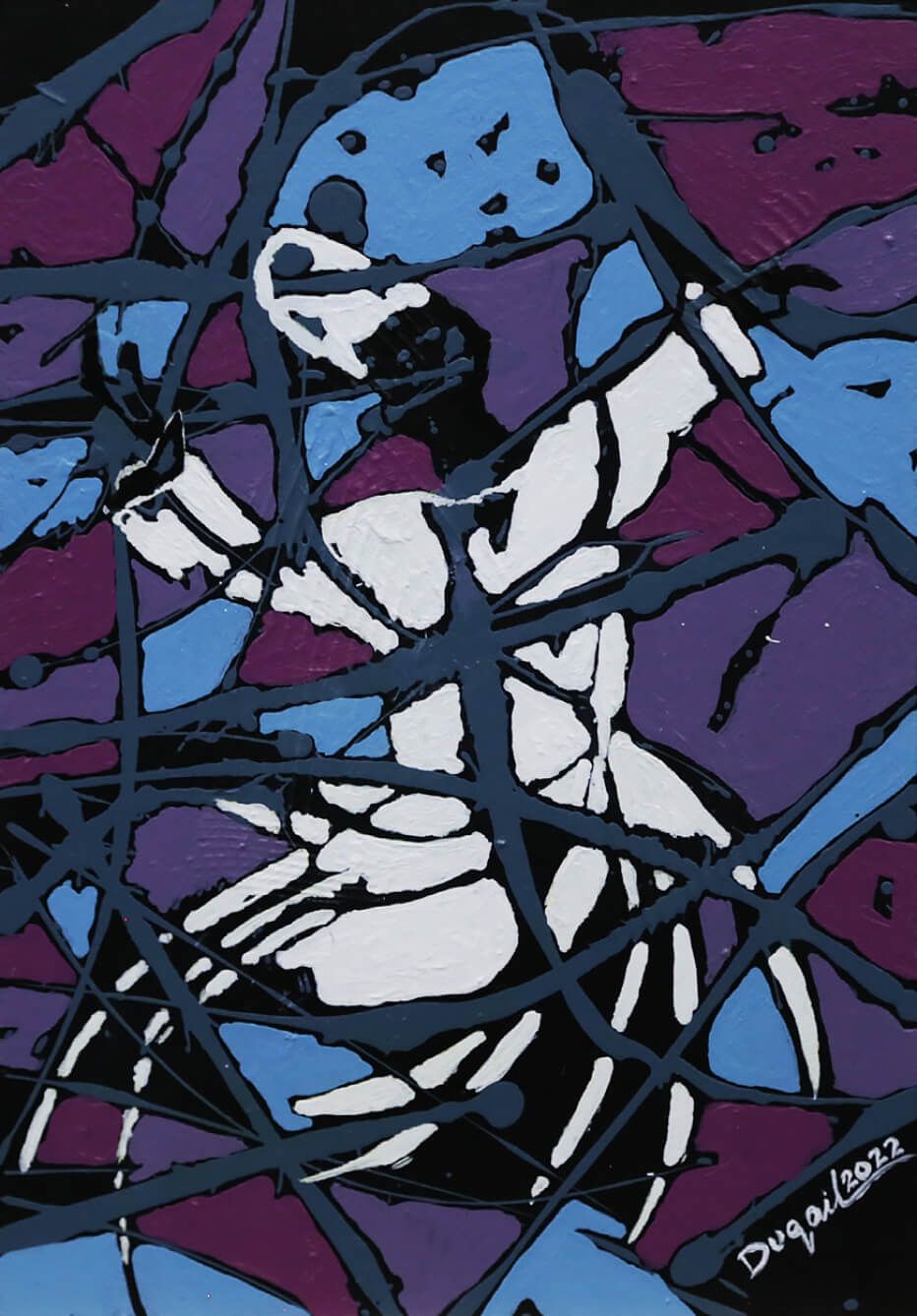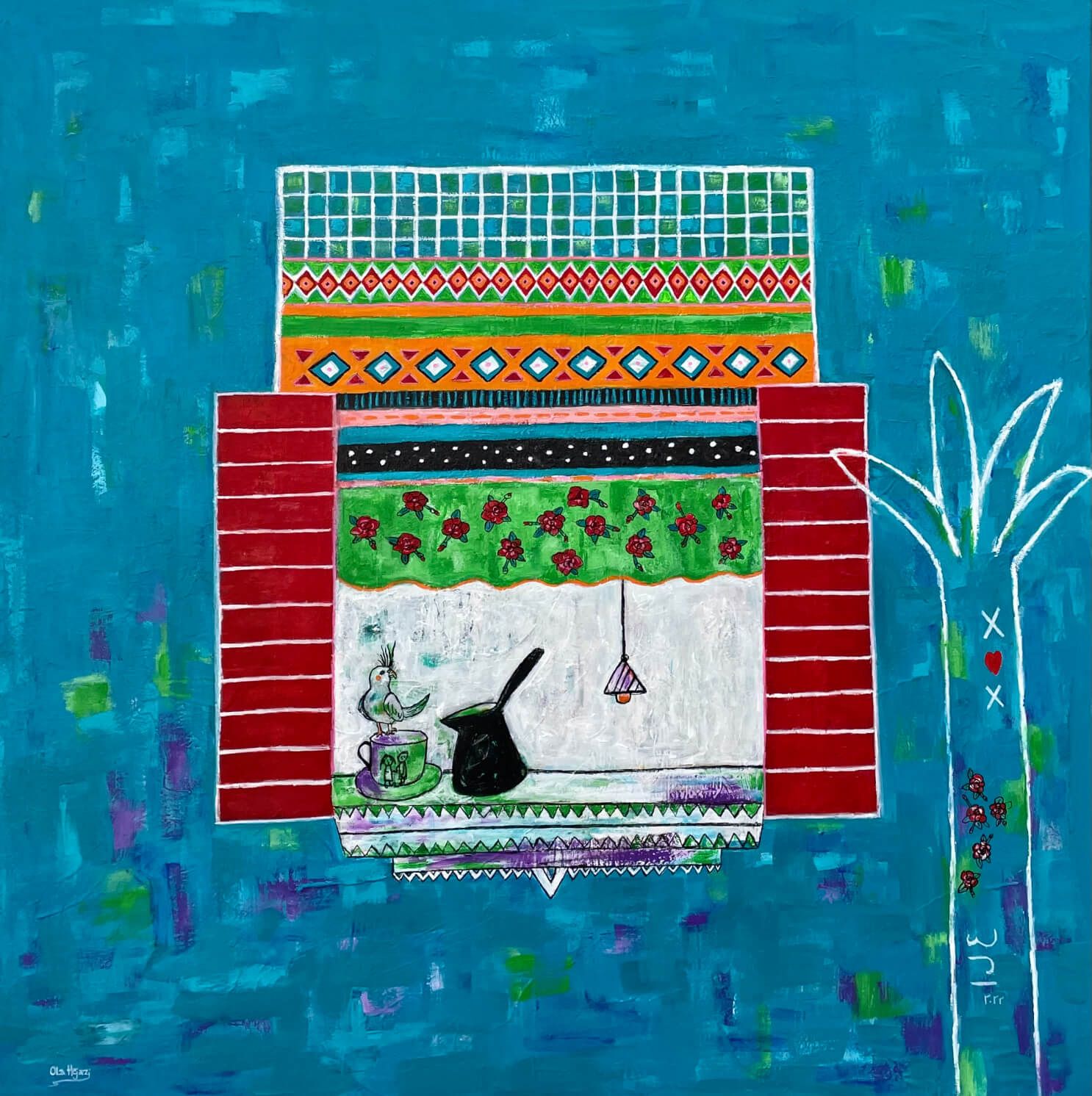Art Therapy
Self- Portrait. Courtesy of the artist.
Dr. Abdulaziz Al-Duqail is a teacher at Taif University and an artist specializing in art therapy. He began his journey as an art teacher for people with special needs, then specialized in the field of art therapy after his study and interest in the therapeutic and rehabilitative aspects of art, and its positive impact on the psychological state of its practitioners. He published several papers that emphasize the importance of fine art in treating people with autism disorder by developing their visual and social communication.
Al-Duqail participated in many local and international exhibitions, where he displayed his abstract paintings that conveyed a story in each corner of the canvas.
Ithraeyat interviewed Al-Duqail and learned more about his journey in the world of art and about his current exhibitions.
Q1: What does art mean to you?
Art, for me, is happiness: in practice, in visual nourishment, in perceiving the depths of feeling. Recently, whenever I draw, I would photograph and post on my Snapchat with the hashtag #art_happiness, and those around me and those close to me knew this hashtag and the emotional state I live in, which sometimes extends for hours without feeling bored or tired. The happiness I feel confirms to me that every artist while practicing his art feels happy and this happiness continues after the completion of his artwork, even if he had started working on it while he was feeling bad. Art is happiness in general for every recipient, visual happiness through the feeling of visual meanings and colors, and happiness in feeling and perception if he contemplates the artwork and understands the implicit message and how he was able to read the work.
Q2: What does "art therapy" mean?
Art therapy has a variety of definitions, but the American Art Therapy Association defines it as:
The therapeutic use of art, within a professional relationship, by people who suffer from illness, psychological trauma, or challenges in life, or people who are looking for personal development, through the creation of art and the reflection of its effects on the outputs and processes that produce them, and art therapy is useful in increasing self-awareness, dealing with symptoms, stress, and painful experiences, enhancing cognitive abilities, and enjoying the joys of life.
Meanwhile, the British Association of Art defines it as:
The process that involves the use of artistic materials with an individual or individuals in a group work, in which the art therapist is associated with the person, with the aim of communicating and understanding each other.
I can summarize the term for the reader as fine art therapeutic processes that depend in general on the use of artistic activities and fields to make the beneficiary reach appropriate solutions to their psychological problems and open the way for them to adapt, all the while learning some artistic methods that help them to live their life in a way that suits them.
Q3: Tell us about your journey in this field, and why did you choose it? How was its study?
My journey began around 1997, when I was working in the field of teaching people with disabilities as an art teacher and how to communicate with them through art. During my work and after many practices and readings, I realized that art is not a promotional activity, but rather has many therapeutic and rehabilitative aspects. I published a book in 2008, “Special Education from the Perspective of Art Education (Facts and Experiences)”, and in the same year I continued my postgraduate studies in this field.

The Game of Life, 2022. Courtesy of the artist.
I completed a Master’s degree in Art Education because there is no specialization that combines art and special education, and by virtue of my experience in which I worked with autistic people, I presented an applied research in art therapy with an autistic student (case study) and how art changed his life.
I obtained a diploma in art therapy (250 hours of theoretical and practical training from the House of Experience Fine Art Therapy affiliated with King Abdullah Center for Research and Studies at King Saud University, which is supervised by art therapy consultant Dr. Awadh Al-Yami), then I pursued a PhD in the Philosophy of Art Education, and submitted my PhD thesis on therapeutic applications with children with autism by preparing a textile therapy program. I currently work as an associate professor in fine art therapy, all thanks to Allah.
Q4: When did you start in the field of fine art therapy? Have you noticed a change in people's impressions of this field?
As I mentioned earlier, it started in a practical way before completing studies and courses, and after obtaining a PhD degree, I continued spreading awareness of this field in a set of training programs, workshops, and scientific conferences in art therapy, and providing consultations. Through the many forums that I have presented, I have noticed a discrepancy in people’s impressions of this field. Some of them are surprised and amazed at the ability of art to treat and rehabilitate, and some of them seek help directly, such as analyzing the current drawings of him or his children, but in general, there is a growing awareness of art therapy and its importance.
In 2020, I gave a lecture on fine art therapy at the Mental Health Hospital in Taif, which is one of the largest psychiatric hospitals in the Arab World. It was attended by a large team of psychological consultants, doctors, specialists, and medical and administrative staff. After the lecture, they recognized the importance of this field and the importance of its existence in the hospital within the work team and treatment programs.

Encounters, Acrylic-canvas, 120*150 cm, 2019, Courtesy of the artist.
Q5: Are there types of art therapy? And what is the most effective type in the Kingdom of Saudi Arabia?
Art therapy offers opportunities for expression and non-verbal communication. The field of art therapy is a large and wide world and encompasses many directions, such as: psychodynamics, innovative art therapy, or cognitive-behavioral therapy with fine art, and more. All are geared towards one goal as a corrective way for emotional problems, and it promotes self-awareness and personal growth, and we cannot judge which is a more effective type because it is related to the status and gender of the beneficiary.
Q6: Tell us which colors are most effective in art therapy and why?
Many studies and literature indicate that color has power. It energizes or calms, excites or soothes, gives a feeling of being hot or cold, disturbs or cheers, generates a sense of passion or lifts spirits, and our understanding of colors gives another dimension to our consciousness, and life without feelings may be called colorless.
There is a path called color therapy, but there is no one color that is more effective in art therapy in general, but the colors have their interpretations and symbols that we work on, and we are keen to reveal their meanings in the fine art therapy sessions. We search for feelings, attitudes and hidden traumas in the subconscious, which can be discovered through practicing the situation, and the preference of one color over another.
Q7: Who is the group that contacts you the most to take art therapy sessions? Age group? Gender?
Fine art therapy is important for all groups, for all people and ages, and for both genders, because it provides a service that everyone needs, whether psychological, rehabilitative or therapeutic, depending on the type of beneficiary. Through long experience in this field, I will say I’ve noticed greater attraction and demand from women. As for the age group, generally the percentage of children is greater. As for adults, the percentage varies according to the region and the prevailing culture. In collective and open meetings, participation in them is often without restrictions. I have presented many workshops, including what was held on World Mental Health Day 2021, where we presented an interactive meeting and workshop. Different age groups participated in it, from 16 to over 50 years old, and their interaction was very impressive.
Q8: What advice would you give to someone who wants to enter this field?
I find a good turnout to enter this field and continuous inquiries, whether in courses or on my account on Twitter, or after public lectures, as it is a unique and interesting field, and my advice to those who wish to enter this field is to be serious and patient and not be satisfied with the husks of knowledge or simple or theoretical courses, as practice is the most important. The field of fine art therapy is an interesting world, but it requires patience, deliberation, deep knowledge, continuous renewal of information and nonstop research.
Q9: You are also a creative fine artist, we would like to know what topics you like to explore and draw in your art? What is your favorite painting?
I have been practicing art since 1993, but starting in 2010, I found in abstract art my purpose and passion and an exploration of hidden worlds in the recipient of the artwork. I sought to find my own style, working on topics that touch feelings and life situations, and that are loaded with specific contents and messages, which I displayed in more than 60 local group exhibitions, as well as international events in Canada, Egypt, Morocco and Jordan.

Manifestation, 2022. Courtesy of the artist
My favorite paintings are what I recently showed in my personal exhibition, entitled “Silence of Stories”, which combined my work asa specialist in fine art therapy and my role as a fine artist.
After the exhibition, I produced works in a new and innovative style while preserving my artistic identity, and I believe that my last work, which I produced in October 2022 and called it “the Game of Life”, is one of my best paintings at the moment, due to the many concepts that I was able to reduce to a singular work of art.
Q10: What is your rule in life?
Life is a constant challenge, and we have to live the challenge with enjoyment, in addition to the importance of continuous renewal that seeks development in all stages of life with patience and endurance, as the poet says:
Do not think that glory is a date that you will eat... You will not attain glory until you lick the bitter juice of aloe
Life without ambition, renewal or achievement is boring and dull, a repetition of days, weeks, months, and years without an actual life.

Agreement and disagreement, 2020. Courtesy of the artist


